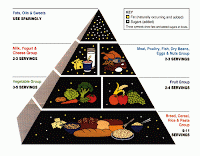Lester Brown, President of the Earth Policy Institute wrote an amazing article in the April edition of Foreign Policy Magazine entitled: The New Geopolitics of Food which NPR recently highlighted in an interview with Mr. Brown. The article does a fantastic job demonstrating how food insecurity and politics are inextricably linked. If you aren't up to reading the article, I've summed up some of the main points below but the full article is definitely worth a read:
Imported food items (often grains) are the most susceptible to rising prices. In countries where poverty prevails, rising prices are felt much more severely. Brown gives the example that a rising price of wheat may mean the difference between $.10-$.20 more for a loaf of bread for us but for cities/countries where grain is purchased in the raw and where 50-70% of income is spent on food, you may actually be paying double the price for your food every day. The frustration and desperation felt by people trying to feed themselves and their families with food they can no longer afford will (and has) lead to political unrest.
Why the issue with rising prices? It's really a simple supply and demand issue.
According to Brown, rising food prices weren't always such a big problem. This year isn't the first year entire crops have been wiped out by drought or heavy rains. It is however one year in a series of years in which supply is dwindling. Richer nations have been able to offset decreases in grain production by using grain stores or by planting on available land. Fortunately, in the past, these types of disasters were uncommon. Currently, however, we are seeing a rise in the frequency of droughts, hurricanes, and formidable weather due to rising global temperatures. Brown cites that a rule of thumb for temperature rise is the 1 degree Celsius rise in temperature will lead to a 10% decrease in grain yields.
We have planted on almost all of the land that is available and much of the land which is vacant is barren. Production is low from poor growing conditions due to global warming, reserves are low or non-existent due to years of increasing frequency of grain shortages and vacant land is either unusable or unviable. Supply is falling short of demand, the latter of which is rising at a rapid rate.
Rising demand is fueled by a few things: increasing population, affluence and biofuels. 219,000 extra mouths to feed every day globally puts a massive strain on global grain production – particularly since most of us consume grains either directly or indirectly as food for animals as a large part of our daily diet. As affluence increases, so does the consumption of cattle and other grain intensive animals as people feel more inclined to eat further up the food chain. Biofuels also increase demand. Brown states that last year we produced 400 billion tons of grain and 125 million was used for ethanol production. Demand has put an intense stain on grain supplies and little to no attention has been given as to how to properly address remedying the situation.
To tackle some of these issues, the article suggests stabilizing the world population through family planning. 215 million women stated they would like to plan families but do not have access to family planning; most of these women represent the poorest populations. Additionally, focusing on raising water productivity will also help sustain grain production. We have tripled our grain production but paid title attention to how to sustainably provide water for the crops.
Brown warns that failing to take climate change and the food crises seriously will result in increasing shortages and rising prices-and we have already had glimpses at what this will mean on a global scale: runaway food prices and riots.
I appreciate Brown’s attempt at taking food insecurity seriously and addressing its underlying causes when it comes to grain production. His well thought out causes of the issue and suggestions for solutions demonstrates the real need for action in this area.
I believe it is also imperative the international community finally get serious about food production/consumption and reassess our food chain and how it is broken. Thanks to Lester Brown for garnering attention to such an important issue.






